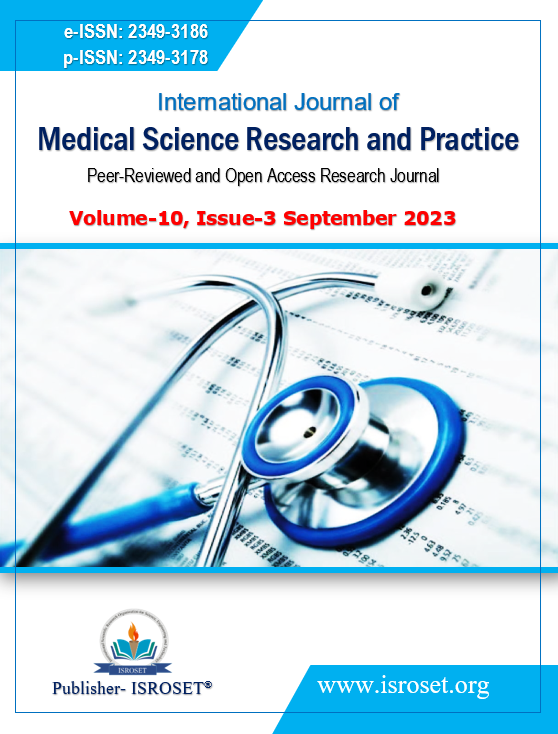Assessment of Common Risk Factors of Non-Communicable Diseases Using Semi Markov Model
Keywords:
Disease, Exponentiated Power Lindley Distribution, Risk Factors, Semi-Markov, Transition ProbabilityAbstract
Background: In several ways, Semi-Markov Process (SMP) is similar towards Markov renewal process, but as in the SMP, a state is determined at all times, just not at the transition periods. As a result, the SMP is a stochastic process that develops over a period. Objective: The proposed Semi-Markov model with Exponentiated Power Lindley Distribution looked at Patients with diabetics and hypertension, Patients with stroke, and Patients with an abnormal heart rate, these changes are through one state to another. Methodology: Inside the Indian subcontinent, there have been no regular data collection methods for cardiac mortality and morbidity, and the numbers of deaths happens in the home, also with cause of death unclear. Exponentiated Power Lindley Distribution was used to characterize patients with Non-Communicable Disease. Results: For each subsequent state, the estimated parameters of the Semi-Markov model with this distribution predicted by maximum likelihood estimation revealed considerable irregularity. The conditional likelihood that the patients will not survive after the time is used to determine the threshold for each transition intensity. Conclusion: The risk for patients with a heart rate is the first to search for among the three non-communicable diseases, as the possibility of survival is limited. The data indicates that the established model is a good fit for many of the attributes seen in the data.
References
Arnoldo and Bernd, “Markov Chains”: Department of Biostatistics, University of Oslo, Norway and Department of Econometrics, Vrije University, Amsterdam, The Netherlands, 2015.
Ashour and Eltehiwy. “Exponentiated power Lindley distribution”. Journal of Advanced Research, Vol.6, No.6, pp.895-905, 2015.
C. J. E. Metcalf, W. J. Edmunds, and J. Lessler. “Six challenges in modelling for public health policy”. Epidemics, Vol.10, pp.93-96, 2015.
G. J. Hankey. “The global and regional burden of stroke”. The Lancet Global Health, Vol.1, No.5, pp.239–240, 2013.
GBD 2015. “Mortality and Causes of Death Collaborators. Global, regional, and national life expectancy, all-cause mortality, and cause-specific mortality for 249 causes of death, 1980–2015: a systematic analysis for the Global Burden of Disease Study 2015”. The Lancet, Vol.388, No.10053, pp.1459–1544, 2016.
Ghitany. M.E., B. Atieh, S. Nadarajah. “Lindley distribution and its application”. Math Comput Simulat, Vol.78, pp.493-506, 2008.
Houston, M. “The role of noninvasive cardiovascular testing, applied clinical nutrition and nutritional supplements in the prevention and treatment of coronary heart disease”. Ther. Adv. Cardiovasc. Dis, Vol.27, pp.1–24, 2017.
Joint committee for the preparation of guidelines for risk assessment and management of cardiovascular diseases in China. Guidelines for risk assessment and management of cardiovascular diseases in China. Chinese journal of preventive medicine. Vol.53, No.1, pp.13–35, 2019.
Levy, P. “Processes semi-markoviens”. Proc. Int. Gong. Math. (Amsterdam), pp.416-426, 1954.
Lindley.D.V. “Fiducial Distributions and Bayes` Theorem”. Journal of the Royal Statistical Society: Series B (Methodological). Vol.20, No.1, pp.102-107, 1958.
M. C. Weinstein, P. G. Coxson, L. W. Williams, T. M. Pass, W. B. Stason, and L. Goldman. “Forecasting coronary heart disease incidence, mortality, and cost: the Coronary Heart Disease Policy Model”. American Journal of Public Health, Vol.77, No.11, pp.1417–1426, 1987.
N. D. Wong. “Epidemiological studies of CHD and the evolution of preventive cardiology”. Nature Reviews Cardiology, Vol.11, No.5, pp.276–289, 2014.
O’Donovan, G.; Blazevich, A.J.; Boreham, C.; Cooper, A.R.; Crank, H.; Ekelund, U.; Fox, K.R.; Gately, P.; Giles-Corti, B.; Gill, J.M. “The ABC of physical activity for health: A consensus statement from the British Association of Sport and Exercise Sciences”. J. Sports Sci., Vol.28, pp.573-591, 2010.
P. J. Easterbrook, M. C. Doherty, J. H. Perrie, J. L. Barcarolo, and G. O. Hirnschall. “The role of mathematical modelling in the development of recommendations in the 2013 WHO consolidated antiretroviral therapy guidelines”. AIDS. Vol.28, pp.85–92, 2014.
S. Ebrahim and G. D. Smith. “Exporting failure? Coronary heart disease and stroke in developing countries”. International Journal of Epidemiology, Vol.30, No.2, pp.201–205, 2001.
Smith, W.L. “Regenerative stochastic processes”, Proc. Roy. Soc. London, Ser. A. Vol.232, pp.6-31, 1955.
Sofi, F.; Capalbo, A.; Cesari, F.; Abbate, R.; Gensini, G.F. “Physical activity during leisure time and primary prevention of coronary heart disease: An updated meta-analysis of cohort studies”. Eur. J. Cardiovasc. Prev. Rehabil. Vol.15, pp.247-257, 2008.
T. A. Gaziano, A. Bitton, S. Anand et al., “Growing epidemic of coronary heart disease in low- and middle-income countries”. Current Problems in Cardiology. Vol.35, No.2, pp.72–115, 2010.
WHO, “Global burden of stroke,” 2015,
WHO. “The global burden of disease: 2004 update. Geneva”: World Health Organization. 2008.
World Health Organization, “Health promotion,” 2018,
Yusuf, S.; Reddy, S.; Ounpuu, S.; Anand, S. “Global burden of cardiovascular diseases: Part I: General considerations, the epidemiologic transition, risk factors, and impact of urbanization. Circulation”. Vol.104, pp.2746-2753, 2001.
Downloads
Published
How to Cite
Issue
Section
License

This work is licensed under a Creative Commons Attribution 4.0 International License.
Authors contributing to this journal agree to publish their articles under the Creative Commons Attribution 4.0 International License, allowing third parties to share their work (copy, distribute, transmit) and to adapt it, under the condition that the authors are given credit and that in the event of reuse or distribution, the terms of this license are made clear.






